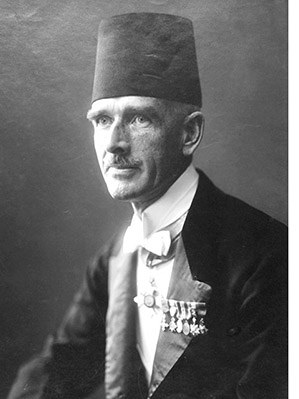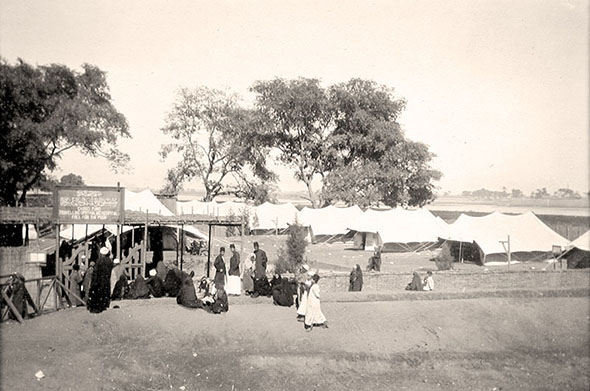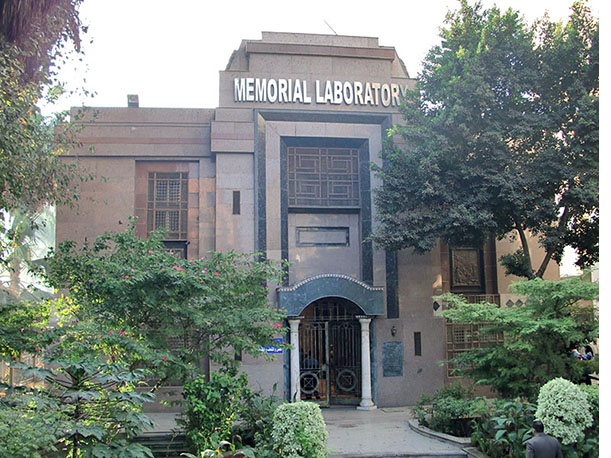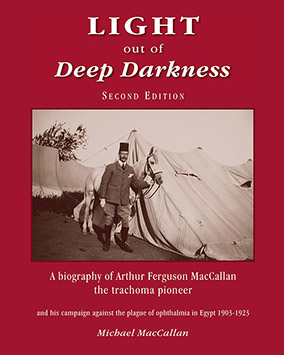Arthur Ferguson MacCallan (1872-1955), the trachoma pioneer
Arthur Ferguson MacCallan (Fig.1) was an ophthalmic surgeon who developed his pioneering work on trachoma (the MacCallan Classification) whilst based in Egypt between 1903-1923. He also established the Egyptian ophthalmic infrastructure, consisting of both permanent and travelling hospitals. On his return to England, he continued his ophthalmic work and his research into trachoma for the remainder of his life.
Ophthalmia (a term relating to the inflammation of the conjunctivae; this includes trachoma, a contagious disease caused by bacterial infection), had blighted the people of Egypt for many centuries. Even at the start of the 20th century, Professor Ernst Fuchs (1851-1930) of Vienna estimated that over 90% of the population (of some 10 million people) were suffering from ophthalmia. MacCallan himself estimated early on that between 7% to 10% of the population were blind in one or both eyes. Unfortunately, there was little effective ophthalmic treatment in the country at that time.
This started to change when Sir Ernest Cassel (1852-1921), the financier and philanthropist, became involved with the construction of the first Aswan Dam (1898-1902). He was shocked at the extent of ophthalmia among the vast workforce and, in 1902, established a Trust Fund of £E40,000 to “teach the principles of ophthalmic surgery to Egyptian surgeons”. This Trust Fund, sufficient to build between 6 to 8 permanent hospitals at that time, was managed by a committee under the Chairmanship of Lord Cromer (1841-1917), the British Consul in Egypt. As a first step, this committee decided to establish an experimental travelling ophthalmic hospital (TOH) similar to those which had been used so successfully in Russia and Hungary. However, someone was needed to manage and develop this initiative and so the committee approached Moorfields for a suitable candidate.
In 1902, MacCallan was practicing at the Royal London Ophthalmic Hospital (Moorfields). MacCallan had been educated at Charterhouse (1886-1891), Cambridge University (1891-1895) and qualified as a medical practitioner. From there he went to St Mary’s Hospital (1895-1900). He was then appointed as House Surgeon at Moorfields (1900-1903). On his application to Moorfields, MacCallan had emphasised that his interest was centred on ophthalmic surgery; during his time there, he assisted all the Surgeons in the operating theatre. In 1903, he resigned from Moorfields, through exhaustion, but was retained as an unpaid chief clinical assistant. By chance, a conversation between two doctors, who were discussing the position in Egypt, was overheard by one of the out-patient Sisters. She exclaimed “Why don’t you ask Mr MacCallan”. MacCallan was delighted to be appointed as Travelling Ophthalmic Inspector and arrived in Egypt in July, 1903.
MacCallan’s first task was to familiarise himself with local conditions; to do this he toured the Egyptian delta area to assess the extent of ophthalmia amongst the local population. This provided him with a first-hand insight as to the extent of the plague of ophthalmia in Egypt.
Later that year, the first TOH was established at Menouf in the Nile Delta and began treating patients, “free for the poor”, in January, 1904. MacCallan’s volume of work was enormous and were conducted in harsh conditions; during the first quarter of 1904, he treated 6157 patients and performed 615 operations. These operations were mostly for malposition of the eyelids as a result of trachoma or as the result of badly performed operations by quack-doctors. Where anaesthetics were required, opium, cocaine or chloroform were used; in some cases, where anaesthetics were unavailable, patients might still insist that the appropriate operation be performed, so great was their desire for the restoration of their sight. This was, of course, the era before antibiotics. So successful was the first TOH and so great the demand for treatment, that in 1904 Cassel agreed to fund a second TOH which started in Fayoum (Fig.2).


Fig. 1 – Arthur MacCallan CBE, MD, FRCS, 1923 |
Fig. 2 – Fayoum Camp. 1904. Note sign “Cassel Fund, Travelling Ophthalmic Hospital, Free for the Poor” |
MacCallan’s early investigations and experiences led him to conclude that ophthalmic resources in Egypt were just “a drop in the ocean” and so he developed a bold long-term strategy for ophthalmic care. First, MacCallan planned to “create a stable central ophthalmic administration” which included training of doctors in ophthalmic surgery. Second, that at least one permanent ophthalmic hospital should be established in each of Egypt’s 14 Provinces. Third, in order to reduce the incidence of ophthalmia, particularly in schools, it was essential to introduce an educational programme in ophthalmic hygiene. Fourth, the TOH scheme should be extended throughout the country as it would bring substantial economic benefits.
MacCallan attacked this huge challenge with determination and a clear vision as to what was needed to ameliorate the suffering of the local population. His seminal work on trachoma included research (MacCallan Classification), surgery and medication (cure), hygiene education (prevention) and securing increased funding (sourced from Government, local councils and wealthy individuals) for developing both the permanent and travelling hospital infrastructure. Over the next twenty years, he established 23 ophthalmic hospital units, including five TOHs, attending to 1.5 million patient visits and performing 76,000 operations, with a further two hospitals planned. Furthermore, he trained some 100 surgeons to resource the expanding hospital network. Arthur also founded the Giza Memorial Ophthalmic Laboratory (now known as the Giza Memorial Institute for Ophthalmic Research - MIOR) (Fig.3) which he considered “the coping stone of my work”. It is a testament to MacCallan’s foresight and determination that many of the permanent hospitals (e.g. Fayoum) and the MIOR continue to play a pivotal role in ophthalmic care and research in Egypt today.
The TOHs, which formed a central pivot to, and acted as a roving advertisement for, the ophthalmic campaign, were extremely versatile as they could bring the hospital to the patients. Initially, they would spend six months in one location and then moved to another selected site. This versatility enabled them, in 1915 under MacCallan’s leadership, to treat the sick and wounded from the military campaigns at the Suez Canal, Gallipoli and Salonica. The largest “hospital under canvas” was initially based in Alexandria with 200 beds; in October, 1915 this moved to Giza and had been expanded to 650 beds. The Director of Medical Services, Egypt Command, officially described MacCallan’s hospitals as “a model of what a war hospital under canvas should be”.
During his time in Egypt, MacCallan strove hard to win the support for his initiatives from both the Egyptian Government and the British Consuls. He had particularly good relationships with Lord Cromer (Consul 1883-1907), Lord Kitchener (Consul 1911-1914) and Lord Allenby (High Commissioner 1919-1925), all of whom supported MacCallan’s vision and initiatives for ophthalmic care. Indeed, Lord Cromer wrote to MacCallan in December, 1914 that “I regard the campaign against ophthalmia as one of the most important and useful works undertaken in Egypt”.
On his return to England 1924 (aged 51), he held a number of professional positions including assistant ophthalmic surgeon at the Westminster Hospital. He officially retired in 1937 but still retained an active research interest in trachoma. In 1944, he was recalled to Westminster Hospital where, for a time, he resumed full clinical responsibility for the Eye Department pending the demobilisation of the permanent staff. He also held a number of positions on ophthalmic committees, the most significant was in 1935, when he was elected President of the International Organisation against Trachoma, a position to which he was regularly re-appointed. In 1936, the President was given a seat on the International Council of Ophthalmology.
Arthur is best known within the international ophthalmic profession for developing the world-famous MacCallan Classification of the stages of trachoma; initially, from 1905, he used this for his own internal analysis. In 1913, he published “Trachoma and its Complications in Egypt”. Later, in 1936, he published his seminal work on “Trachoma”. In 1952, the World Health Organisation (WHO) adopted the MacCallan Classification as its then standard. Whilst the WHO grading system has subsequently been redefined, the MacCallan Classification acted as a foundation on which others could build.
In recognition of the moral significance of Arthur’s dedicated commitment in battling the plague of ophthalmia, the Egyptians accorded him the rare privilege, particularly as a foreigner, of dedicating a commemorative bust in his honour. This was unveiled in 1931 and remains on display inside the MIOR.
There has recently been a revival of interest in MacCallan’s work, particularly given resonance by the current WHO initiative to eliminate trachoma worldwide. In 2014, the International Coalition for Trachoma Control (ICTC) inaugurated the ICTC MacCallan Medal, to celebrate their tenth anniversary. Then, in 2018, the National Centre for Translation (NCT), part of the Egyptian Ministry of Culture, requested permission to translate MacCallan’s biography, “Light out of Deep Darkness”, (Fig.4) into Arabic, with a publication date scheduled for late 2019.
Thus, MacCallan’s exceptional skills, his pioneering spirit, his humanitarian campaign for the relief of suffering and his accomplishments of over a century ago, continue to resonate with the international medical and ophthalmic profession today.


Fig. 3 – The Memorial Institute for Ophthalmic Research (MIOR), Giza |
Fig. 4 – Front cover of “Light out of Deep Darkness” showing MacCallan at Menouf Camp, 1904" |
Selected Literature and Further Reading
MacCallan, M. 2018. Light out of Deep Darkness, a biography of Arthur Ferguson MacCallan, the trachoma pioneer. Second Edition. The Choir Press, Gloucester, 352 pp. (ISBN 9781911589440).
Michael MacCallan
(Grandson)
London, 2019
Published the 28th June 2019


